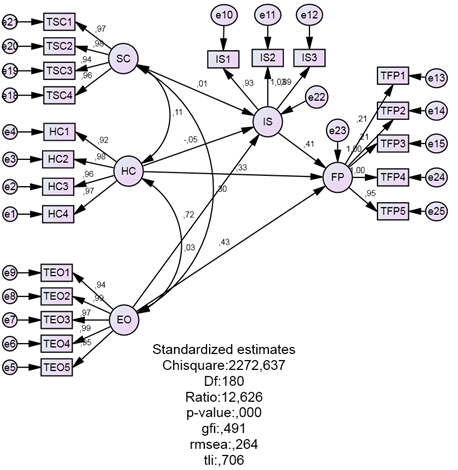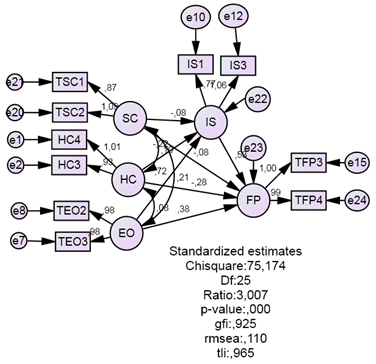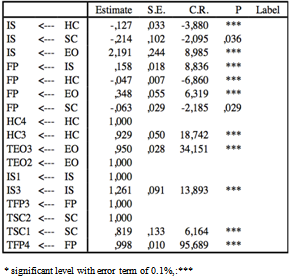-
Paper Information
- Next Paper
- Paper Submission
-
Journal Information
- About This Journal
- Editorial Board
- Current Issue
- Archive
- Author Guidelines
- Contact Us
American Journal of Economics
p-ISSN: 2166-4951 e-ISSN: 2166-496X
2013; 3(1): 1-6
doi:10.5923/j.economics.20130301.01
The Direct Effect of Entrepreneurial Orientation and Innovation Success on Firm Performance
Aluisius Hery Pratono 1, Tee Chee Wee 2, Dicky Hida Syahchari 3, Andhyka Tyaz Nugraha 4, Nik Kamariah Nik Mat 4, Hadiati Fitri 5
1Faculty of Business and Economics, Universitas Surabaya, Surabaya, 60293, Indonesia
2Facultyof Business and Finance, UniversitiTunku Abdul Rahman, Perak, 31900, Malaysia
3Faculty of Economics, Universitas Tama Jagakarsa, Jakarta, 12530, Indonesia
4College of Business, Universiti Utara Malaysia, Kedah, 06010, Malaysia
5Faculty of Economics, UniversitasYARSI, Jakarta, 10510, Indonesia
Correspondence to: Aluisius Hery Pratono , Faculty of Business and Economics, Universitas Surabaya, Surabaya, 60293, Indonesia.
| Email: |  |
Copyright © 2012 Scientific & Academic Publishing. All Rights Reserved.
Innovation plays pivotal role in whole business competition, while small firms in developing economies face challenging issue to invest in innovation. The research aims to examine the impact of innovation success as mediator variables on relationship among entrepreneurial orientation, human capital, social capital and firm performance.Hence, this research wants to contribute to the literature of product development management. With independent variables of entrepreneurial orientation, human capital and social capital, the research employs sample of small and medium enterprise from Malaysia and Indonesia.Through employed innovation success as moderator variable, the research indicates positive relationship between entrepreneurial orientation and firm performance. However, the evident highlights negative relationship between human capital and firm performance as well as social capital and firm performance.
Keywords: Entrepreneurial Orientation, Innovation Success, Human Capital, Social Capital, Firm Performance
Cite this paper: Aluisius Hery Pratono , Tee Chee Wee , Dicky Hida Syahchari , Andhyka Tyaz Nugraha , Nik Kamariah Nik Mat , Hadiati Fitri , The Direct Effect of Entrepreneurial Orientation and Innovation Success on Firm Performance, American Journal of Economics, Vol. 3 No. 1, 2013, pp. 1-6. doi: 10.5923/j.economics.20130301.01.
Article Outline
1. Introduction
- It appears that innovation plays pivotal role in whole business competitiveness. Many world-class companies with a huge number of famous innovative products started from zero, such as Google, Apple, Tata, Samsung. However, millions of small enterprises fail during the earlier years of their establishment.While Schumpeter emphasized the role of agent with ‘a creative destruction’ to challenge toward economic development[1][2], the entrepreneur process in developing countries is associated with ‘creative imitation’ refers to process from elsewhere in the world with different level of adhocracy[3]. Lee and Zhou[4] argue that innovation success springs from evolution of innovation from creative imitation to creative innovation.Successful innovation is a different story between large manufacturing companies and small firms. Largemanufacturing companies experience remarkable investment in new technologies and equipment with world-class skills.On the other hand, there is complex challenge for small firmsto achieve innovation success due to lack of resource in R&D activities[5]. Then, uncovered questions from previous research regarding the innovation in small enterprises need to be taken into account. For example, Rubera and Kirca[6]raised a question about the performance of firm’s innovation, while Baker and Sinkula[7] called for contingent research, which integrate entrepreneurial orientation and order of entry.This research aims to examine the mediator role of innovation success to effect of entrepreneur orientation, social capital, and human capital on firm performance. Hence, this research wants to contribute to the literature of product development management through addressing the research gap, proposed by Maria do, et al[8] about the need of moderator for success in innovation.The following discussion comprises three issues. The first part examines a literature review to propose hypothesis with firm performance as dependent variable, whileentrepreneurial orientation, social capital and human capital considered as dependent variable. The second part focus to deal with empirical analysis employed structural equation model to examine the proposed model and provide revised model. The last part prevails the conclusion with some future proposed research toward a contingent research.
2. Literature Review
- The literature review addresses the concept of innovation success, followed by hypothesis development.
2.1. Innovation Success
- Ample empirical evident provides the contention that the innovation success of small business. The distinction between innovation success and innovativeness needs to be taken into account. According to Baker &Sinkula[7], innovation success refers to the concrete result, which springs from innovation process, while the ‘innovativeness’ as an element of entrepreneurial orientation is associated with openness to new idea.Hao& Yu[9] draw a distinction between two mainstreams of researches with aims to explain innovation success, which are external and internal. The external factors constitute collaboration among partnerships, while the internal factors refer to business strategy, corporate culture and technology capability. Regarding the process innovation, a successful process yields to increasing efficiency and quality enhancement[10]. Mario do, et al.[8] indicates the major elements of innovation success refer to strategic leadership, management of technology, and organization culture. However, environmental uncertainty affects entrepreneurial learning as an item of entrepreneurial learning, which then impacts innovation propensity[11].The best way to judge the success of a firm is by how well it does relative to its competitors[12]. Firms with poor innovation and lack of research and development heavily rely on their rivals' knowledge to maintain their technological capacities[13].The notion that firms can improve their innovativeness to meet the needs of customers has become prominent in innovation studies. However, Ru-Jen Lin et al[14] indicate that not all customer relationship management activities contribute to innovation programs. The challenge springs from organizational practices, such as intensive communication, rewarding employees for sharing and acquiring knowledge, and high levels of delegation of decision rights[15]. On the contrary, small firms have more advantage to build close relationship with customers, which enables them to develop unique and innovative features to fulfil their customers' needs[16].This also becomes apparent that sustainable innovation represents innovation success. The present study will advance understanding on firm's sustainable innovation processes by framing this phenomenon as an organizational capability[17]
2.2. Hypothesis Development
- The framework constitutes three independent variables, i.e. entrepreneurial orientation, social capital and human capital. The independent variable is firm performance, while innovation success is mediator variable. Then the framework comes up with four hypotheses:H1: Social capital affects innovation successSocial capital (SC) is a relevant variable for innovation success. The social capital can encourage employees to enhance their knowledge without suspicion and concealment, through external and internal sources, and converted into new ideas for innovation[17][18]. On the other hand, Xiao et al.[11] indicate that the interaction between innovation success and social capital can be negatively due to environmental information uncertainty.H2: Human capital affects innovation successHuman capital (HC) is another determinant variable for innovation success[18]. Gallié&Legross[19] find positive and significant effects of R&D intensity and training on patenting activity. In the context of small firms, research and development activities tend to be high-risk exposure, high fixed cost, high minimum investment, and severe financial constraint[20].H3: Entrepreneurial orientation (EO) affects innovation successEntrepreneurial orientation (EO) plays pivotal role in improving a firm’s performance[21]. There are some ground breaking researches provide evident about positive impact of entrepreneurial orientation on small firm performance [7][22].H4: Innovation success affects firm performanceSome empirical researches provide evident that innovation success contributes to firm performance[7][9] [23]. Baba[24] points out that adopting a specific innovation type in services sector contribute more to performance than adopting bundles of different types of innovation.H5: Social capital affects firm performanceSome researches provide evident that relationship between social capital (SC) and firm performance is positive [25][26][27], while cognitive dimension of social capital gives impact on operating profit[28][29]. However, small firms are less likely to collaborate than large firms due to unequal balance, which followed by poor firm performance [34].H6: Human capital affects firm performanceThe level of the human capital positively affects firm performance. While individual develop more efficient, thereby it can helps increasing organization performance[30]. Ployhart et al[31] indicated that human capital, which developed from education qualification, training and work-related experiences, lead to organization performance. The large firms tend to experience positive effect of human capital on return of sales[33]. In addition, this positive effect is not universal because in some scenarios it is not significant.H7: Entrepreneurial orientation affects firm performanceEntrepreneurial orientation is important variable for firm performance. Some researches provide evident thesignificant impact of entrepreneurial orientation on firm performance [21][22][32].
3. Methodology
3.1. Empirical Setting
- This empirical study focuses on manufacture and services small medium enterprises for small and medium enterprises. The questionnaires adapted from Baker[7] and Wu[18]. Then structural equation model is used to examine the impact of innovation success as mediator variable to the model with firm performance as dependent variable and entrepreneurial orientation, human capital and social capital as independent variable.
3.2. Data Collection
- The data collection commenced in Johor Bahru Malaysia and Palembang Indonesia with random selected respondent from small medium enterprise units. After screening some irrelevant respondent and replacing some missing data with median and transforming to ensure normality distribution, 168 data was used for data analysis.
4. Analysis
4.1. Exploratory Factor Analysis
- Initially, there are seven items of EO (entrepreneurial orientation), six items of SC (Social Capital), eight items of Innovation Success (IS), and ten items of FP (firm performance). Before doing exploratory analysis, validity and reliability test take place.The Cronbach’s alpha indicates that all variable are pretty good with rate beyond 0.6. The lowest reliability test came to moderator variable IS, followed by FP. The independent variables indicates higher level of reliability, i.e. SC: 0.78, EO: 0.89, HC: 0.9. This step allows the survey with such questionnaires. Exploratory factor analysis with SPSS provides KMO test of 0.706, which indicates that patterns of correlations tend to be relatively compact. Bartlett’s test value is 1035 with significant level of nearly 0, which means null hypothesis of identity matrix is rejected. The factor analysis identified three factors,At the early steps, total variance explained output indicated five components. The step reduced some items, such as EO6, EO7, SC5, SC6, IS4, IS5, IS6, IS7, and IS8.
4.2. Confirmatory Factor Analysis
- Framework analysis started with proposed framework. During the first step with AMOS analysis, the framework was not able to meet the standard of goodness of fit. The proposed framework revealed RMSEA test of 0.264, which indicates that parsimony principal was rejected, while a good model fit would provide an insignificant result at a 0.05 threshold. Other measurement also indicates similar results. GFI (Goodness of Fit Index) was 0.491 or much lower than expected value of 0.9, which needs revising. The result of revision indicated that revised model is a better than the proposed one. After reduction some factors, the framework met the goodness of fit with GFI of 0.925 and this also happened with TLI of 0.96. However, the model had not yet met the RMSEA measurement, which means this framework doesn’t meet the parsimony principle (table 1).
|
4.3. Parameter Estimation
- The parameter estimation indicates that the moderator variable of innovation significantly affected the relationship between HC and FP as well as EO and FP. However, this didn’t work with SC and FP. The level of significant of coefficients of HC (human capital) on both FP and IS are quite low with type of error of 5%.
|
 | Figure 1. Proposed framework |
 | Figure 2. Revised framework |
5. Conclusions
- Innovation success in the context of small medium enterprises is quite challenging. The mainstream of references in social capital and human capital tend to fail to explain such phenomenon in small medium enterprises. Through employed innovation success as moderator variable, the research indicates negative relationship between human capital and firm performance as well as social capital and firm performance.The research also indicate high level of goodness of fit index, which means 92% of the total variation in firm performance explained by the framework. However, the parsimony principle is not accepted. Another limitation is the small sample size due to low level of respond rate.Then, the research suggests that the future research needs to address some omitted variables, for example the public policy intervention and relationship with financial institutions. Some mediator variables represent local context need to be taken into account.In addition, the mixed result calls for qualitative research can explore some new factors, especially social capital and human capital in small firm context.For the policy with aim to promote small and medium enterprises, the evident suggest more supports on human capital. This should take into account the high-risk exposure and high fixed cost, which bring about severe financial constraint for small enterprises.
 Abstract
Abstract Reference
Reference Full-Text PDF
Full-Text PDF Full-text HTML
Full-text HTML
